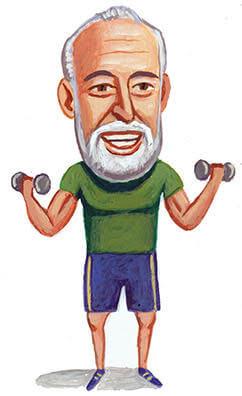October 4, 2017

Merle Power! Living Long and Prospering
By Kurt Waltenbaugh and David W. Johnson
Merle Phillips is a petite 110-year old 4’9” fireball who keeps doing big things. She’s writing her twelfth book and recently created a new version of Scrabble to pitch to game-maker Hasbro. Reaching 110 makes Merle a “super-centenarian.” This is a most exclusive club. There are likely fewer than 50 American super-centenarians alive today.
Merle doesn’t act old. Her 110th birthday party was a colorful, butterfly-themed extravaganza at Belmont Village, her assisted-living senior community in Carol Stream, Illinois. Guests included two mayors, her minister, dozens of close friends, local firefighters, children she babysat until “retiring” at age 99, nieces, a great nephew, and her great, great niece is 98 years younger and two inches taller than Merle.
Merle’s “Memories Mural” was the party’s centerpiece. Merle papered this large poster-board mural covered with colorful slips recognizing special associations, events and pleasures. Merle’s memory slips included: “50+ year member of Wheaton Wesleyan Church,” “Mission in Puerto Rico,” “Ice cream,” and “Each ironed shirt = one kiss from Leonard.” Merle savored every moment.
Merles All Over the World
What accounts for Merle’s ultra-longevity and, more importantly, her high life quality? While having “good genes” influence lifespan, “social determinants of health” play an even more significant role in health, well-being and longevity.
Social determinants are inter-personal, economic and environmental factors that shape the lives of all people. These social determinants shape individual and community health, wellness and well-being. They include neighborhood vibrancy, proximity to parks, connections to friends, diet, daily rituals, spending habits, engagement in meaningful work, alcohol use and political activism. Human beings crave connection. That’s why loneliness can be toxic and pet ownership can enhance well-being.
In a joint study, National Geographic and author-explorer Dan Buettner searched for the sources of happy and healthy aging.[1] Buettner’s research team investigated societies across the world where people live unusually long and active lives. They named the most successful societies “Blue Zones” and they included Sardinia, Italy; Okinawa, Japan; and Loma Linda, California.

Observing people in Blue Zone communities between the ages of 84 and 112, Buettner’s team discerned clear patterns. The thriving elderly were physically active; intimately connected to family and community; practiced rituals associated with faith; consumed healthy diets; and engaged in meaningful work.
Based on his research, Buettner concluded that “A long healthy life is no accident. It begins with good genes, but it also depends on good habits.”[2]
While there were many similarities among Blue Zone communities, there were also differences. The Sardinian diet includes pecorino cheese and red wine. Pecorino cheese is protein-rich and full of omega-3 fatty acids which lower harmful inflammation and triglycerides. Red wine is high in antioxidants that retard cardiovascular disease.
On Okinawa, long life links to purposeful daily work, or “ikigai.” This translates roughly as “that which makes one’s life worth living.”
In Loma Linda, California, a community with a high concentration of Seventh Day Adventists, residents lead rich spiritual lives, engage in community service, and consume plant-based diets while avoiding alcohol, caffeine and tobacco.
Buettner also discovered that there is strength in connection. Social isolation is virtually unknown in Blue Zones. Living in concert with like-minded people creates a positive social contagion that nudges others toward life-enhancing behaviors. Consequently, Blue Zone communities largely avoid the obesity, heart disease, cancer and depression that plague most U.S. communities.
Blue Zones work. Their constructive socialization enriches health, happiness and vitality. It’s time to reverse-engineer the Blue Zone formularies and introduce their attributes into American communities that have forgotten how to live in harmony with their neighbors and nature.
Zip Codes versus Genetic Codes
Death may be inevitable, but premature death is preventable. Researchers quantify premature mortality by identifying those who die before an adjusted-mean age (e.g. 65 in the US) and calculating the “Years of Potential Life Lost” (YPLL). For example, an American who dies at age 60 has a YPLL of 5 years.
The National Community Mapping Institute mapped cumulative YPLL per 100,000 people. Notice the stark regional variations:

Areas of the country with higher YPLL rates suffer from negative social determinants, including low incomes; reduced job opportunities, poor transit, lack of nutritious foods, sub-standard housing, inadequate health care; lower education levels and limited access to nature. These variations in social determinants influence longevity and health more than an individual’s genetic make-up. Nurture beats nature. Zip codes influence health status more than genetic codes.
YPLL data helps analysts measure the relative health of communities. The Centers for Disease Control (CDC) has concluded that 43% of premature U.S. deaths result from unhealthy lifestyle habits.[3] “We have known for decades that the ‘actual’ causes of premature death in the United States are not the diseases on death certificates, but rather the factors that cause those diseases,” says Dr. David Katz, director of Yale University’s Prevention Research Center.[4]
Dr. Tom Frieden, director of the CDC agrees: “There are far too many places in the country where, just by the unfortunate fact that you live there, you are much more likely to die from a preventable cause.”[5]
How to Live Long and Prosper
Americans like to win. Here’s how to win at ageing well: Live free of disease and disability to an advanced age and then die fast. The scientific term for having long healthy lifespans is “compressed mortality.”
Healthy aging pioneer and Stanford Medical School professor, Dr. James Fries, puts it this way: “By minimizing the number of years people suffer from chronic illness, we enable older people to live more successful, productive lives that benefit themselves and society.”
Merle’s life provides a shining example. When asked on her 110th birthday to identify the “secret” to her health, happiness and long life, here’s what we learned:
- Merle doesn’t smoke
- She never eats to excess (skipping desert for most of her adult life!)
- She rides a stationary recumbent bicycle 45 minutes each day
- She participates in weekly “Flex and Fit” exercises classes at Belmont Village
- She attends bible study twice-weekly
- She’s a member of a book club that meets monthly
- She plays Scrabble and Pinochle frequently with friends
- She volunteers
- She attends Sunday services at Wheaton Wesleyan Church, where she has been a member of the congregation for 50 years
- She’s optimistic by nature (“Have a good attitude and don’t dwell on bad things.”)
- She’s active by nature (“Keep moving!”)
- She’s mentally agile and creative (“Use your brain!”)
Research supports the efficacy of Merle’s strategy with two thumbs up. The CDC determined the following 5 healthy behaviors significantly reduce rates of cancer, cardiovascular disease, diabetes, and dementia, increasing longevity:
- Avoiding tobacco
- Eating a healthy, plant-based diet
- Remaining active (30 minutes of moderate exercise daily)
- Maintaining a healthy weight
- Avoiding or limiting alcohol consumption
Research supports these findings:
A 2006 study published in the Archives of Internal Medicine followed 6500 middle-aged and elderly people in the US for 20 years. When the study began, 3500 participants were ages 45-64. Those who were obese, physically inactive, smoked or had diabetes or uncontrolled high blood pressure at the start of the study required greater amounts of nursing home care.
Middle-aged smoking increased the chance of nursing home admission by 56%; physical inactivity by 40%; uncontrolled high blood pressure by 35%. Contracting diabetes more than tripled the risk of nursing home admission while diminishing life quality and lifespan.[6]

Exercise not only benefits physical health but invigorates mental vitality and cognitive capability. According to an April 2017 BBC report, 39 medical studies across the UK and Australia determined that “thinking and memory skills” improved when people engaged in physical activity that increased heart rate and muscle strength.[7]
Daily aerobic exercise improved cognitive abilities such as thinking, reading, and learning and reasoning. Muscle training – using weights and resistance training 2 or more days a week – enhanced memory and the brain’s capacity to plan and organize through “executive functions.”
A recent Lancet Commission on Dementia Prevention and Care concluded that global dementia would diminish by a third with improvement in controllable lifestyle factors. Exercise, nutrition and social and cognitive stimulation dramatically reduce the likelihood or onset of dementia.[8]
Social life is also critical. “Perceived Social Isolation” (PSI), i.e. loneliness, increases the risk of developing chronic illness, particularly in the elderly.[9] Loneliness causes higher inflammation levels and weakens the immune system’s ability to combat viral infections and dementia.[10] A Brigham Young study determined that loneliness increases mortality risk by at least 30%,[11] the same mortality impact as smoking 15 cigarettes a day.[12]
In other words, while genetics and luck play a role in living a long and healthy life, controllable lifestyle choices can extend or diminish lifespan.
Dan Buettner agrees:
“The calculus of aging offers us two options: We can live a shorter life with more years of disability, or we can live the longest possible life with the fewest bad years. As my centenarian friends show me, the choice is largely up to us.”[13]
Should I Stay or Should I Go?
Nobody wants a long life compromised by extensive ill health or dementia. Quantity of life is most desirable when accompanied by high life quality. Compressed mortality exemplifies the highest standard of human existence.
Merle Phillips’s exemplary life illustrates the powerful benefits of healthy living. With healthy eating, healthy behaviors, regular exercise and social and mental engagement, Merle has prolonged her lifespan by decades.
It requires a concerted national effort to reduce health inequities across populations and reverse negative lifestyle behaviors. Improving social determinants for broad swaths of the American public demands the collective commitment of practitioners, payers, policy-makers, individuals and communities to advances lifestyle improvement programs.
The alternative is catastrophic: more chronic disease, lower productivity, increased social isolation, unhealthy communities, greater inequality and ever-higher healthcare spending. That’s a future that no Americans want for our country.
American healthcare must go beyond treating sickness and injury. To improve national life quality, productivity and living standards, America’s healthcare system also must enhance the health and wellness of individuals and communities. As former Cleveland Clinic CEO Toby Cosgrove proclaimed, “The state of our nation depends on the state of our health.”
[1] http://news.nationalgeographic.com/2015/04/150412-longevity-health-blue-zones-obesity-diet-ngbooktalk/
[2] https://bluezones.com/wp-content/uploads/2015/01/Nat_Geo_LongevityF.pdf
[3] https://www.cdc.gov/mmwr/preview/mmwrhtml/00001773.htm
[4] http://time.com/84514/nearly-half-of-us-deaths-can-be-prevented-with-lifestyle-changes/
[5] http://time.com/84514/nearly-half-of-us-deaths-can-be-prevented-with-lifestyle-changes/
[6] http://jamanetwork.com/journals/jamainternalmedicine/fullarticle/410241
[7] http://www.bbc.com/news/health-39693462
[8] https://www.washingtonpost.com/local/social-issues/healthier-living-could-reduce-worldwide-dementia-by-a-third-report-says/2017/07/19/e40438be-6cc0-11e7-96ab-5f38140b38cc_story.html?hpid=hp_hp-more-top-stories_dementia1230am%3Ahomepage%2Fstory&utm_term=.11d6f3900591
[9] http://www.pnas.org/content/112/49/15142.full.pdf
[10] https://www.theatlantic.com/health/archive/2015/12/loneliness-social-isolation-and-health/418395/?utm_source=atlfb
[11] https://www.forbes.com/sites/quora/2017/01/18/loneliness-might-be-a-bigger-health-risk-than-smoking-or-obesity/
[12] http://www.telegraph.co.uk/science/2016/08/24/having-no-friends-could-be-as-deadly-as-smoking-harvard-universi/
[13] http://www.richroll.com/podcast/danbuettner/






